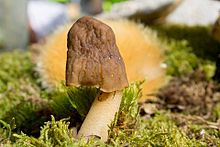Verpa conica – Wikipedia
From Wikipedia, the free encyclopedia
Species of fungus
Species of fungus
Verpa conica, commonly known as the bell morel or the early morel, is a species of fungi in the family Morchellaceae. Sometimes mistaken for a true morel (genus Morchella), this species is an “early morel” characterized by a cap resembling a thimble that is freely attached to the stem.
Taxonomy[edit]
The species was first described under the name Phallus conicus by Otto Friedrich Müller in 1775. Later authors have moved the taxon to various genera: Persoon placed in Leotia in 1801, Samuel Frederick Gray transferred it Relhanum in 1821, while Otto Kuntze moved it to Monka in 1898. The species was transferred to Verpa by Olof Swartz in 1814.[1]
Description[edit]
Fruiting bodies have a smooth cap that is bell-shaped or conical, and 1 to 4 cm (3⁄8 to 1+5⁄8 in) tall and broad;[2][3] it is attached to the top of the stem only, the margin of the cap is free – hanging like a skirt. The underside of the cap is tan to dark brown in color. The stem, which measures 2 to 12 cm (3⁄4 to 4+3⁄4 in) by 1 to 3 cm (3⁄8 to 1+1⁄8 in) thick, is whitish[4] and either equal or slightly thicker than the base;[3] the stem surface is either smooth or slightly fuzzy.[5] It is generally hollow, although young specimens may be filled with cotton-like hyphae. The flesh is thin and brittle, and the cap can be easily broken off the stem.
David Arora notes that sometimes a variety with a wrinkled cap can be found, somewhat resembling a Gyromitra.[6]
Microscopic features[edit]
Spores are elliptical, smooth, colorless,[3]hyaline, with dimensions of 28–34 by 15–19 µm. The asci are typically 500–550 by 21–27 µm, and eight spored. The paraphyses are club-shaped, branched, and septate.[7]
Similar species[edit]
Since the cap is free in V. conica, it is easily distinguishable from true morels. True morels attach at the base of the cap. V. conica mushrooms attach at the top of the cap—so they are even distinguishable from half-free morels. This mushroom also tends to be filled with a cotton material, whereas morels are hollow all of the way through.
Other similar species include Verpa bohemica and Mitrophora semilibera.[3]
Distribution and habitat[edit]
This species grows singly, scattered, or in groups on the ground in both hardwood and coniferous forests, often in river valleys, or along stream banks.[7] It often fruits in late spring, usually near morel season. It has been reported to fruit abundantly in the chaparral scrubland in southern California.[6]
Edibility[edit]
Verpa conica, like Verpa bohemica and closely related Morchella species, are edible once cooked,[8][9] although caution is advised.[10]
Use as an antioxidant[edit]

There is evidence that V. conica may contain compounds that function as an antioxidant. While not necessarily recommended for consumption, it is possible that an extract from V. conica could be used as an antioxidant supplement. A study done on the antioxidant activity of various mushroom species indicates that this species of Verpa does particularly well in reducing power. They also do well in binding iron, which may be related to peroxidation protection.[11]
References[edit]
- ^ a b “Verpa conica (O.F. Müll.) Sw. 1814″. MycoBank. International Mycological Association. Retrieved 2011-05-06.
- ^ Kuo M (January 2005). “Verpa conica“. MushroomExpert.Com. Retrieved 2011-05-06.
- ^ a b c d Davis, R. Michael; Sommer, Robert; Menge, John A. (2012). Field Guide to Mushrooms of Western North America. Berkeley: University of California Press. pp. 393–394. ISBN 978-0-520-95360-4. OCLC 797915861.
- ^ Trudell, Steve; Ammirati, Joe (2009). Mushrooms of the Pacific Northwest. Timber Press Field Guides. Portland, OR: Timber Press. pp. 278–279. ISBN 978-0-88192-935-5.
- ^ Healy RA, Huffman DR, Tiffany LH, Knaphaus G (2008). Mushrooms and Other Fungi of the Midcontinental United States. Bur Oak Guide. Iowa City, Iowa: University of Iowa Press. p. 297. ISBN 978-1-58729-627-7.
- ^ a b Arora D. (1986). Mushrooms Demystified: a Comprehensive Guide to the Fleshy Fungi. Berkeley, California: Ten Speed Press. p. 795. ISBN 0-89815-169-4.
- ^ a b Tylutki EE. (1979). Mushrooms of Idaho and the Pacific Northwest. Moscow, Idaho: University Press of Idaho. p. 42. ISBN 0-89301-062-6.
- ^ Jordan M. (2004). The Encyclopedia of Fungi of Britain and Europe. London, UK: Frances Lincoln. p. 57. ISBN 0-7112-2379-3.
- ^ Weber NS, Smith AH (1980). The Mushroom Hunter’s Field Guide. Ann Arbor, Michigan: University of Michigan Press. p. 39. ISBN 0-472-85610-3.
- ^ Phillips, Roger (2010). Mushrooms and Other Fungi of North America. Buffalo, NY: Firefly Books. p. 363. ISBN 978-1-55407-651-2.
- ^ Elmastas, Mahfuz; Isildak, Omer; Turkekul, Ibrahim; Temur, Nuri (2007). “Determination of antioxidant activity and antioxidant compounds in wild edible mushrooms”. Journal of Food Composition and Analysis. 20 (3–4): 337–345. doi:10.1016/j.jfca.2006.07.003.
Recent Comments